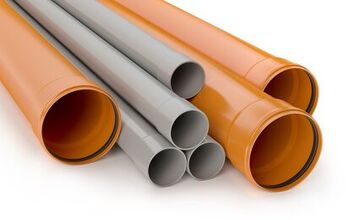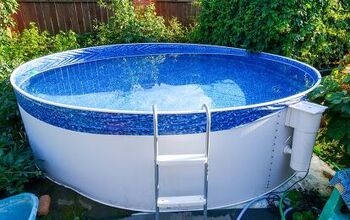What Size PVC Pipe Is Needed For A Gutter Drain?

Gutters are a critical part of any home or building. Their primary purpose is to keep your home or property structurally sound by directing water away from your property’s foundation. This will help prevent erosion, flooding, staining of the property’s exterior, discoloration of paint, and prevent mold and mildew growth.
There are different types of gutters, and one of those is homemade with PVC pipe. You can make the gutters, and the gutter drains with PVC pipe. The question you may have is what size PVC pipe should I use for a gutter drain?
The standard size PVC pipe for the gutter drain is 4″ in diameter. It is rare, but some may go as low as 3″ in diameter, but it depends on the size and width of the gutter on the house. Connecting the drainage pipe must be the same size as the gutter, and most are 4″. The length of the PVC pipe depends on how far you are from the drainage ditch or drainage system. You want the drainage pipe as far away from the house as possible.
Do You Need to Hire a Plumber?
Get free, zero-commitment quotes from pro contractors near you.

How to Install a PVC Pipe for Drainage
Drainage pipes are an essential part of your gutter system. It is the part of the system that guides the water away from your property’s foundation. It is a durable material and you can even use PVC on CPVC. Listed below are the steps on how you could use a cheap PVC pipe for drainage.
Tools and Equipment You Will Need
- Trencher
- 4″ PVC pipe or 3″ (Depending on the size of the gutter)
- Construction mark spray
- Tape measure
- Half-round file
- Spirit level
Step 1: Research the Regulations
Make sure you know the stormwater regulations for the area that your property is on. You can do this by contacting a local building or house inspection company. Different cities, counties, and countries have different rules regarding stormwater regulations, so make sure you know the rules where you begin.
Step 2: Know Where the Underground Lines Are Located
Before you start digging, you should make sure drainage will not go through any cables or pipes in your yard. You can do this by contacting your local cable and gas companies to see where those reside in your yard. Do not start digging without knowing where these lines are, as this can be dangerous to you and your neighbors.
Step 3: Mark the Pathway
Find the location of the downspout of your gutter system. Then mark the desired path of your drainage pipe using construction mark spray.
Step 4: Dig the Trench
Begin trenching at where your construction mark spray ends. Use your trencher to trench down 16 inches. Dig the trench from the end of your construction spray to the down to the spout of your house.
Step 5: Smooth Out the Trench
Once your trench is made, make sure that the bottom of it is smooth with no rocks or sticks in the way.
Step 6: Connect the Spout Adapter
Once your trench is ready, connect your spout adapter to the bottom of the rain gutter.
Step 7: Connect the Pipe to the Adapter
Connect your measured PVC pipe to the adapter at the bottom of the rain gutter.
Step 8: Connect the PVC Pipeline to the End of the Trench
Connect as many pieces of PVC pipes that you need to reach the end of your trench using spout adapters, elbows, and connectors.
Step 9: Cover the Pipe
Once your pipe is laid out, use gravel to fill the trench and cover the pipe back up. If any of the pipes are not on the ground, add support by shoveling dirt underneath that section of piping.
Step 10: Pack the Dirt
Pack the dirt evenly across the top of the trench.
Make a decision on where you want your gutter drain to be located in your yard. Try to decide where water would naturally flow if your home or property were not there. It will ensure the water still flows somewhat naturally, and no damage will happen to your home or any neighbors’ homes.
If you are uncomfortable setting up your gutters draining system yourself, you can always reach out to a professional. Through Google, you can find a gutter company with a good reputation to help fix your problems. They are professionals and will make sure everything is done correctly to avoid damages.
Gutter Maintenance Tips
You want to do routine checks on your gutters a couple of times a year. Make sure that they are not getting clogged and that they are draining correctly. You can do this by getting a ladder and clearing any debris out of the gutter.
For safety, make sure that you always secure your ladder on sturdy ground to prevent any injury. If you need to, have somebody hold the base of the latter to stabilize it.
The Importance of Properly Sloped Gutters
You may ask, what is a gutter slope? The gutter slope is the degree to which the gutter slants downwards for the water to flow through. If the slope is too horizontal, water will pool inside the gutters and not flow towards the downspout.
On the other end of things, if the gutter is too steep, this will cause problems as well. The water will flow through the pipe too quickly and start to pool on the ground. Most professionals recommend that you want about a quarter-inch of slope for every ten feet of gutter.
It’s important to know that this is an average recommendation, and not all houses or properties should use this recommendation. The slope depends on the property’s structure, the length of the gutters, and the kind of gutters that you have. If you aren’t sure what to do while installing your sloped gutters, you can always reach a local gutter protection expert.
How to Deal with Improperly Sloped Gutters
Most gutter protection experts recommend that people do not try to fix their improperly sloped gutters by themselves. If people try to fix the problem independently, they typically make it worse.
They will not position their gutter at the correct slope. This will leave your home exposed to water damage.
Based on this, we recommend finding a gutter company with a good reputation to help fix your problems. They are professionals and will make sure everything is done correctly to avoid damages.
Different Types of PVC Pipes You Can Use
Every person’s home will be different, and you will need to find the PVC pipe that works for your gutter system.
Rigid PVC Pipes
This is the recommended pipe when doing gutter work. It is four inches in diameter. Before buying this pipe, we recommend that you check with your local building department to follow the correct ordinances. Compare seamless to regular gutters and decide what’s best for you.
Flexible Pipe
You will want to use flexible drainage pipes if you find yourself needing to maneuver the pipe around an obstacle. Some obstacles can include cables or gas lines, a big rock, or a tree. Before buying this pipe, we recommend that you check with your local building department to follow the correct ordinances.
Downspout adapters can help you connect your PVC pipes as needed. These come in many sizes, so you should not have a problem finding a size that can connect your pipes.
Your length of pipe will depend on how far you need your pipe to run to the nearest sewer. It should go far enough away from the house to prevent any damage to the house’s structure. Before buying this pipe, we recommend that you check with your local building department to follow the correct ordinances.
Gutter Material
Gutter is made out of sturdy material. It can not contain any mercury, lead, or other hazardous materials that could drain with water and cause harm to people or the environment. The most common materials that are used to make gutters are aluminum, galvanized steel, and PVC.
Do You Need to Hire a Plumber?
Get free, zero-commitment quotes from pro contractors near you.

Choosing the Right Size Gutter Wedge
Not every gutter needs a gutter wedge, but if yours does, it’s not hard to figure out. You will need a gutter wedge if you find that your gutter does not work efficiently. This appliance is common if your gutter does not fit against your home.
Wedges will help ensure a long-lasting bond between your gutter and your house. Gutter wedges typically come in two different sizes. The first size is five inches, and the second size is six inches.
The size of the wedge that you should get depends on the size of your gutter. If you have a larger gutter, then you will most likely go with the bigger size of six inches. If you have a smaller gutter, then you will most likely go with the smaller size of five inches.
Deciding which gutter wedge size to get, you should take careful notes and measure your gutter correctly. If this is not done from the beginning, everything will be offset. When you know your gutter’s draining system measurements, it should be easy to get the correct gutter wedge.

We are a team of passionate homeowners, home improvement pros, and DIY enthusiasts who enjoy sharing home improvement, housekeeping, decorating, and more with other homeowners! Whether you're looking for a step-by-step guide on fixing an appliance or the cost of installing a fence, we've here to help.
More by Upgraded Home Team



























